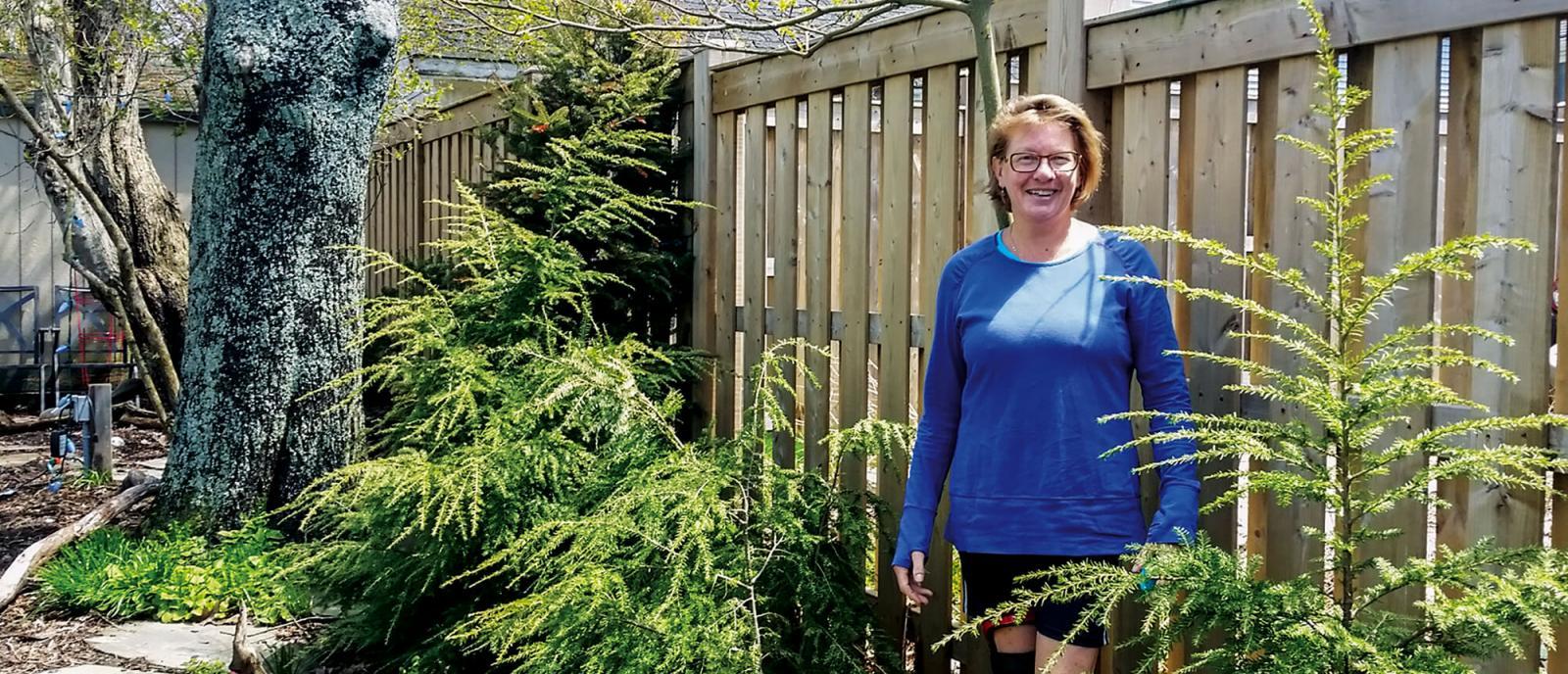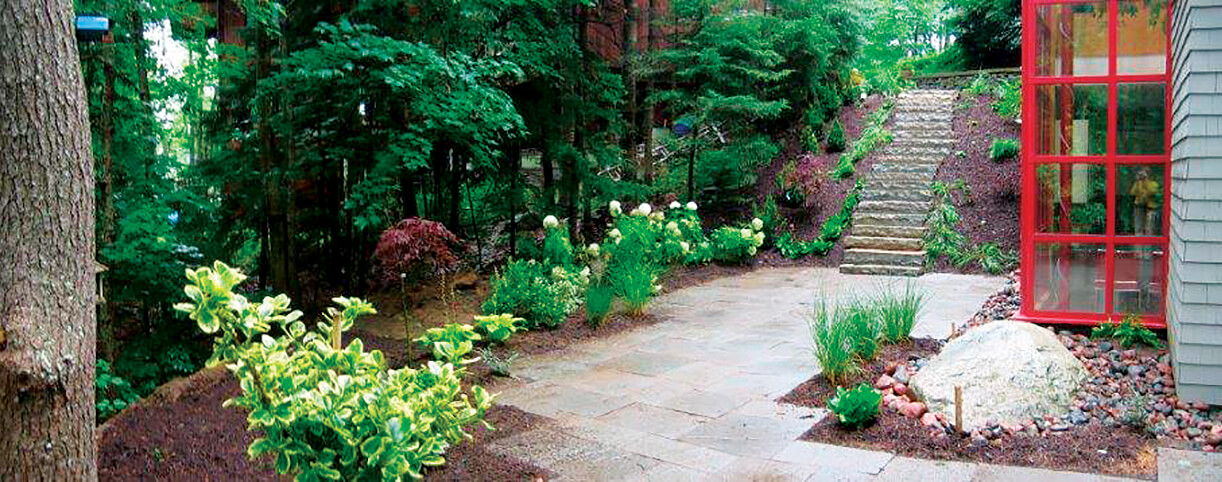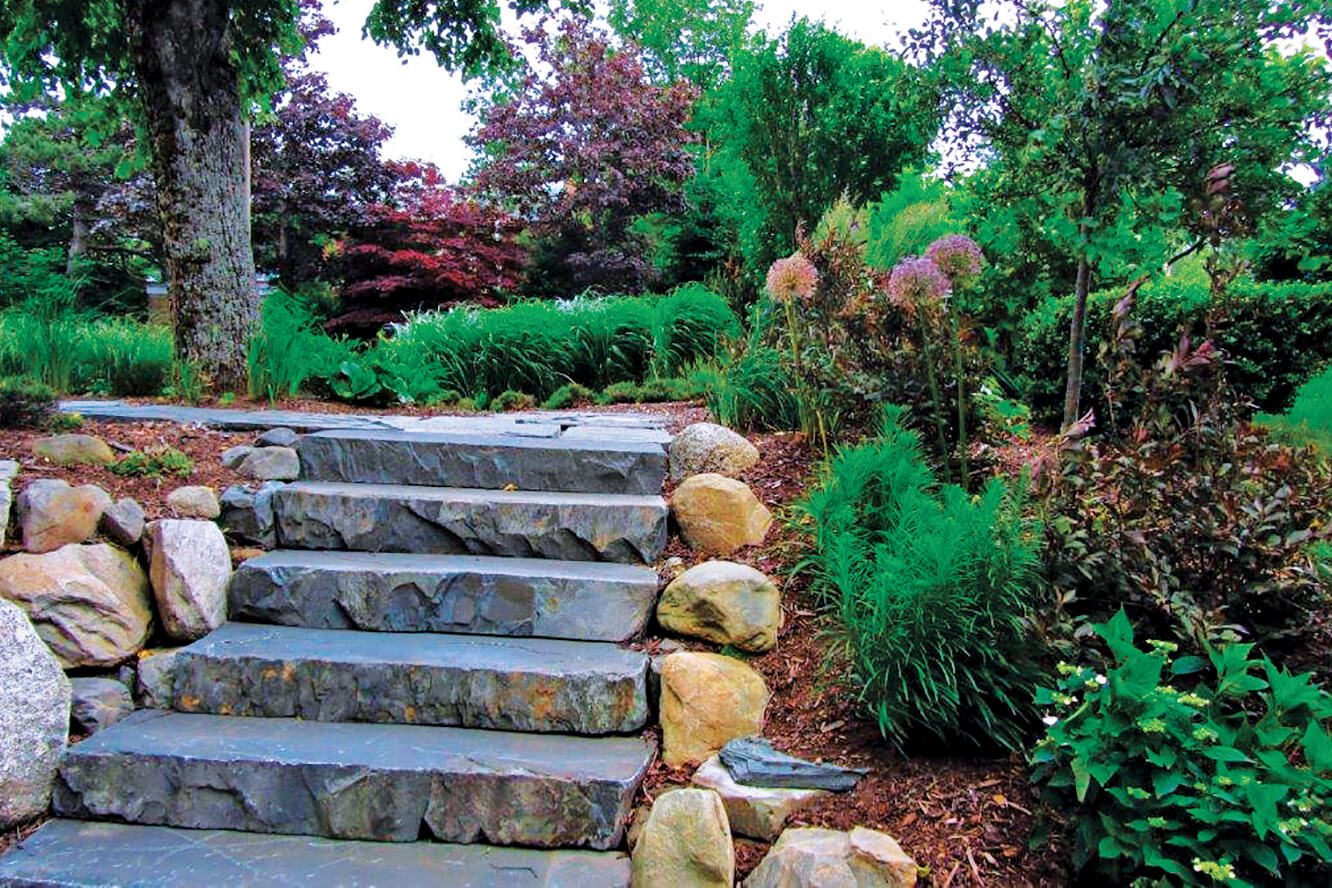May 2, 2018

Linda van Vulpen
A designer's story
Linda van Vulpen CLD on her career in landscape design
AS INTERVIEWED BY ANITA JACKSON CLD
A career change led Linda van Vulpen to enrol in a Nova Scotia Agricultural College (NSAC) horticulture program, and become one of Atlantic Canada’s most respected landscape designers. Now retired, she reflects on her profession with designer Anita Jackson.
AJ: I recall you were an early adopter of CAD in landscape design.
LV: I had this great big thick manual on how to self-train. I spent the winter working on it every day, and I learned to do my own design work in AutoCAD.
AJ: What about your symbols and graphics? Did you develop those?
LV: The software had a few tree and shrub symbols built into the program, although I found they cluttered the drawings. The specification drawings for tree planting or concrete driveways, etc. were all drawn by myself in AutoCAD. Some came directly from Associated Landscape Contractors of America’s Installation Landscape Training Manual for Installation Technicians, of course crediting this manual. For others like concrete, I went to the industry itself to get the information.
A lot of information is required to create a good set of drawings, and there was a lot of learning. It took years to develop so the information was logical and not confusing. We also got away from plotters, as printers producing 11x17 printouts came to the market at very reasonable prices. Then it became simple to convert drawings into PDF format. I was able to make one main printout for the client and copy the package onto a DVD, allowing clients to email finished drawings to the contractor or make copies of their own. A package could then be as large as 10-20 pages, with each focused on specific relevant information; one page would address grades, another dimensions, a third might have explanation notes and so on.
AJ: What year did you go out on your own?
LV: It was late June of 1995. I remember trying to contact landscapers to tell them how I could help them, but they wouldn’t talk to me. So, it was not the best of years. But I had a few friends of friends who called on my services. I just drove everywhere. I probably spent as much money trying to find work as I was paid in those days. I tried phone calls, friends-of-friends, I probably did some work for next to nothing or because I just wanted the practice with AutoCAD. The second year I volunteered with Landscape Nova Scotia at the Ideal Home Show, working in their booth. I got a couple of jobs and I remember thinking, “Okay this is where I have to be,” so in ‘97 I took my own booth. I got a lot of work and that got me off my feet. Then my partner and I separated. It was a stressful year, but it worked out well.
 Space must have a purpose and functionality.
Space must have a purpose and functionality.
AJ: Over your career you’ve been involved with quite a number of organizations, Landscape Nova Scotia (LNS), the Atlantic Association of Landscape Designers (AALD), Hort East…
LV: I joined the Nova Scotia Home and Building Designers Association (NSHBDA). There was a nice overlap with what they did and I did. They were a very progressive organization They had many of the same issues as landscape designers. They had to deal with right-to-practice issues as well as Name Act matters. NSHBDA taught classes on CAD design, Google SketchUp, construction matters, solar and other low energy consumption design, design creativity, as well as inviting guests (including myself) to speak on topics related to design in and out of building structure. I saw a lot of commonalities that were shared between the NSHBDA and AALD.
AJ: Tell me a little about your relationship with Landscape Nova Scotia. I noticed on your drawing notes about liability insurance, making sure that landscape contractors had proper insurances. You used the specifications from the CNLA. So, were you getting good information from that group?
LV: Yes, I did use the CNLA specifications for all things related to site preparation through to the care required after the job was completed. Over time, I modified these specifications considerably, to better represent what was required for the job and to make them an easier read for the client.
AJ: I noticed that you attach construction details.
LV: They originally were based on what I was taught at NSAC, but it became obvious to me many of these practices were not always possible and with new materials, construction details changed.
AJ: With Landscape Nova Scotia, did you have any special relationships? Who did you recommend to clients to install your designs?
LV: I had to trust “word of mouth.” I remember going to Ross Godfrey and asking for a recommendation. He gave me Tony Pierce’s name. I’ve been working with Tony Pierce since. Landscape Nova Scotia meetings provided opportunities. I met Doug Conrad through LNS and we maintained a strong working relationship for many years. He gave me practical pointers on how to make my drawings more realistic. He asked if I would accept his advice and I said I wanted and needed to hear it. I also met and worked with Russell Beakhouse of Groundcover Landscaping.
I did my NSAC work term with Earthcraft Landscaping. That experience brought the reality of design and landscaping into place. I do believe this experience is quite essential, and I probably could have used more.
AJ: How would you describe your design style?
LV: I feel my style is about functionality. How a space had to have purpose. As the contemporary began to move in, I found myself really liking it.
AJ: By contemporary you mean more minimalistic?
LV: Yes, I suppose. It wasn’t that it was easier to design. I liked working with different forms and dealing with space in a different kind of way. I was getting bored with curvy lines and multitude of colour. This provided an opportunity to explore something different. The design still had to be practical. This angular design style could be quite high maintenance. A lot of contemporary gardens displayed in design magazines were impractical, like the ‘right-angle’ garden bed — unless metal edging was used — an expensive consideration for the client. White or near-white large, square cut concrete slabs would stain with our vegetation debris. Our climate with lush vegetation and lots of rain is just not suited to a white paving material.
 Designers must consider the practicality of their work and ensure materials used are suitable to each project location.
Designers must consider the practicality of their work and ensure materials used are suitable to each project location.
AJ: You mentioned you were referencing magazines. How did you get inspiration?
LV: I didn’t have anyone to banter ideas about with, so I collected books like crazy. It seems to me Pinterest is a more recent source of inspiration. I did scour the internet and began to rely on it a great deal for inspiration near my last years of design practice.
AJ: Talk about those booksere there any by Van Oehme and Sweden? The New American Garden style? Did you buy books by plant interest or by site?
LV: I bought books for plant interest in the earlier years, and later for design styles. Some books were about naturalized gardens, green roofs, natural elements and simplicity as in The Scandinavian Garden by Karl-Dietrich Buhler. And then The Gardens of Russell Page by Marina Schinz and Gabrielle van Zuylon would show designs of ‘controlled’ nature or very strong traditional Italian styles. Many other books would be specific to a topic like estate design, pools, stone, decks or water.
AJ: As they say landscape design is an art and a science, particularly when understanding and creating environmental plantings like a meadow. You can buy a lot of meadow mixes, but they are mostly annual seed, and then you need proper mowing regimes and a sickle bar mower or whatever. It’s not an easy thing. The lawn is still with us.
LV: It seems that way. With the increased tick populations in Nova Scotia, a meadow may not be so attractive to many clients.
AJ: What about plant pathology issues, like picking phloxes that don’t mildew and crabs with scab resistance? There is so much to it to do it well.
LV: There is, and I’m kind of getting away from that now. I’m just poking around in my own space, which I didn’t have the opportunity to do before, and I’m enjoying that. I’ve read about some landscape architects focused on maintaining as natural a landscape as possible on their own properties. I find that interesting because I felt that we (designers) were not creating nature, and yet we market ourselves as nature creators.
AJ: We are creating artificial environments.
LV: I have been creating native woodland habitats on this city lot I currently live on with my husband. I have transplanted native plants from my parents’ woodlot in Pictou County. As small as these spaces are, looking upon these soft native plants is the best, most soothing part of the entire lot. These plants include an assortment of ferns, hemlock and Cornus alternifolia (pagoda dogwood). I also dragged mossy logs back to the garden. It gave me great pleasure when I was able to convince a client NOT to cut down that piece of natural woodland which she didn’t know what to do with. A job well done was being able to provide the client a vision of this woodland as a haven worthy of saving and visiting, to educate this person on its value to the natural life dependent upon it and to make it accessible and enjoyable.
AJ: Any advice for those starting off in the landscape design business?
LV: I would advise a new designer to return calls in a timely manner, be on time when appointments are scheduled, be a good listener, take good notes, be respectful at all times. The design should be realistic and understanding of the installation process. The best way to appreciate that is to get experience in installation and talk to contractors. The ‘business’ of design takes almost as much time as designing. Keep good records and practice good organization skills. Don’t get behind on all things to do with business.
Anita Jackson CLD runs a design consultancy from Seabright, N.S., and is an enthusiastic garden history researcher.